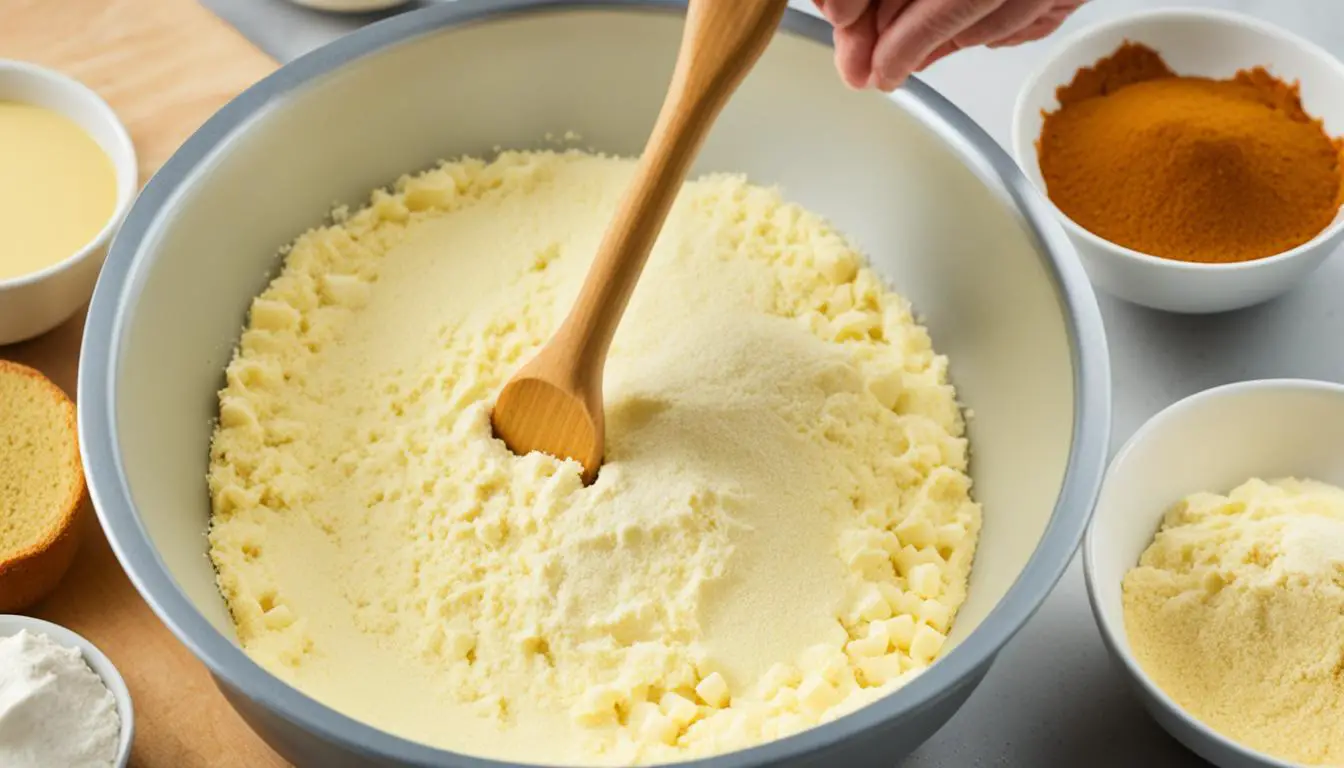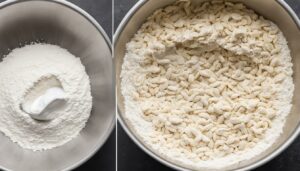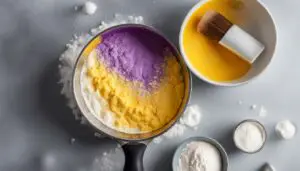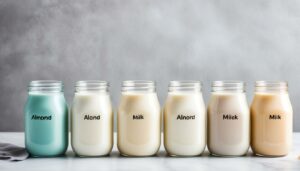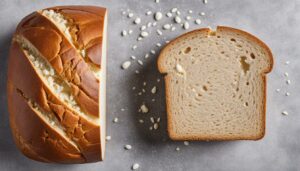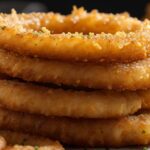Originally posted on February 10, 2024 @ 8:22 am
Yeast cake is an essential component of many baking recipes, playing a crucial role in achieving light and fluffy results. But what exactly is yeast cake, and how does it contribute to the baking process? Let’s delve into the definition and significance of yeast cake in recipes.
Yeast cake, also known as fresh yeast or compressed yeast, is a type of yeast that comes in the form of a cake or block. You can typically find it in the dairy section of grocery stores. Made up of living organisms, yeast cake feeds on sugar and undergoes fermentation, converting the sugar into alcohol and carbon dioxide. This fermentation process creates air bubbles, resulting in the dough’s rise and giving yeast-based recipes their characteristic texture.
Yeast cake is perishable and highly recommended for baking yeast-based pastries. Its transformative power in recipes enhances flavor, texture, and overall baking success. Now that we understand what yeast cake is, let’s explore its ingredients, uses, and how to bake with it.
Contents
- 1 Yeast Cake Ingredients and Uses
- 2 The Process of Baking with Yeast Cake
- 3 Tips for Successful Yeast Cake Baking
- 4 Choosing the Right Flour for Yeast Cake Baking
- 5 Overcoming Intimidation and Mastering Yeast Cake Baking
- 6 Understanding the Different Forms of Yeast
- 7 Converting Dry Yeast to Yeast Cake
- 8 The Importance of Resting and Kneading Dough
- 9 Common Challenges and Troubleshooting Tips
- 10 Favorite Yeast Cake Recipes
- 11 Conclusion
- 12 FAQ
- 12.1 What is yeast cake in a recipe?
- 12.2 What are the uses of yeast cake?
- 12.3 How do you use yeast cake in baking?
- 12.4 What are some tips for successful yeast cake baking?
- 12.5 What is the best flour for yeast cake baking?
- 12.6 How can I overcome the intimidation of yeast cake baking?
- 12.7 What are the different forms of yeast?
- 12.8 How do you convert dry yeast to yeast cake?
- 12.9 Why is resting and kneading the dough important in yeast cake baking?
- 12.10 What are some common challenges in yeast cake baking and how can they be overcome?
- 12.11 What are some favorite yeast cake recipes?
- 12.12 What are the benefits of yeast cake and some tips for baking it?
- 13 Source Links
Key Takeaways:
- Yeast cake is a type of yeast that comes in the form of a cake or block.
- It is made up of living organisms that undergo fermentation, resulting in the rise of yeast-based recipes.
- Yeast cake is perishable and recommended for baking yeast-based pastries.
- It enhances flavor, texture, and overall baking success.
- Understanding the definition and significance of yeast cake is essential for successful baking.
Yeast Cake Ingredients and Uses

Yeast cake is made up of a few key ingredients that are essential for yeast dough. These ingredients include:
- Wheat flour (all-purpose or Polish type 550)
- Yeast (instant, rapid-rise, or fresh bakers yeast)
- Milk or water
- Eggs
- Sugar
- Butter or olive oil
- Salt
These ingredients are combined and kneaded to create a smooth and satiny dough. Yeast cake is versatile and can be used in a variety of recipes such as bread, rolls, pastries, and cakes. It adds flavor, texture, and helps the dough to rise.
Yeast Cake Ingredients
| Ingredients | Usage | Benefit |
|---|---|---|
| Wheat flour | Forms the base of the dough | Provides structure and texture |
| Yeast | Facilitates fermentation | Allows the dough to rise |
| Milk or water | Acts as a liquid component | Hydrates the ingredients and adds moisture |
| Eggs | Enhances richness and increases binding | Improves the texture and structure of the dough |
| Sugar | Feeds the yeast and adds sweetness | Aids in fermentation and caramelization |
| Butter or olive oil | Provides fat content and flavors | Enhances taste and texture |
| Salt | Adds flavor and regulates fermentation | Enhances overall taste of the dough |
With these ingredients, you can create a wide range of delicious baked goods using yeast cake. From soft and fluffy bread to delicate pastries, yeast cake lends its unique qualities to elevate your baking creations.
The Process of Baking with Yeast Cake
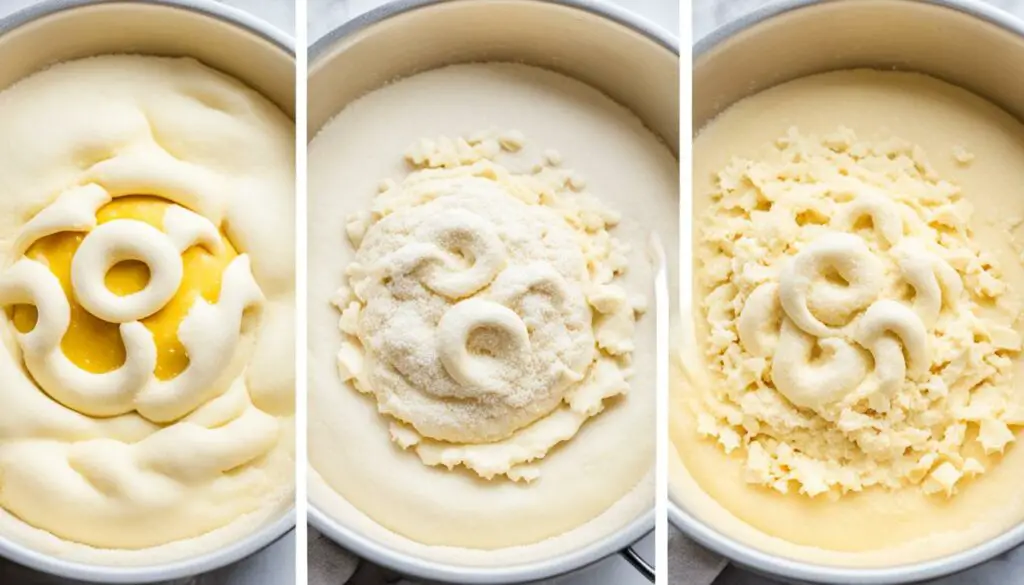
Baking with yeast cake involves a simple five-step process. Understanding these steps will help you successfully use yeast cake in your baking endeavors.
- Mix and Knead: Start by mixing the ingredients for your dough, including the yeast cake, with other essential components like flour, sugar, and water or milk. Knead the dough until it becomes smooth and satiny, ensuring proper gluten development and even distribution of yeast throughout.
- Resting Period: After kneading, allow the dough to rest in a warm environment for approximately one hour. During this time, the yeast activates and ferments, leading to the production of carbon dioxide gas. This gas causes the dough to rise and double in size.
- Shaping: Once the dough has doubled in size, it is ready to be shaped into the desired pastry, whether it’s a loaf, rolls, or a specialty pastry. Be creative and experiment with different shapes and sizes.
- Second Rise: After shaping, give the dough another 30 to 60 minutes of rest. This second rise allows the yeast to continue working, resulting in a final increase in volume and improved texture.
- Baking: Preheat your oven to a temperature of 325-350 degrees Fahrenheit. Place the shaped dough in the oven and bake for a minimum of 25 minutes or until the pastry has a golden brown crust. The baking process ensures that the yeast completes its fermentation, resulting in a delicious finished product.
By following these steps, you can achieve beautifully risen and flavorful baked goods using yeast cake. The combination of proper mixing, resting, shaping, and baking will result in a delightful treat for you and your loved ones to enjoy.
Tips for Successful Yeast Cake Baking
To ensure successful yeast cake baking, there are a few tips to keep in mind:
-
Provide the dough with a warm place to rest: Yeast thrives in warmth, so it is important to find an ideal temperature between 70 and 80 degrees Fahrenheit for the dough to rise properly.
-
Adjust baking temperature based on sweetness: When baking a recipe with a high sugar content, it’s essential to lower the baking temperature. This prevents the cake from browning too much on the surface.
-
Use more yolks, fewer whites: For airier and plumper cakes, use a higher ratio of egg yolks to whites in your recipe. This will help create a lighter texture.
-
Grease the pastry appropriately: Maintain the freshness of your yeast cake by greasing it with an appropriate amount of butter or olive oil.
-
Track the resting time: Keeping track of the resting time is crucial to ensure that the dough has enough time to rise properly. Refer to the recipe instructions for the recommended resting time.
-
Add salt to enhance flavor: Don’t forget to add salt to the dough. Salt enhances the flavor of the yeast cake, giving it a delicious taste.
Following these tips will help you achieve successful and delectable yeast cake baking results!
Choosing the Right Flour for Yeast Cake Baking
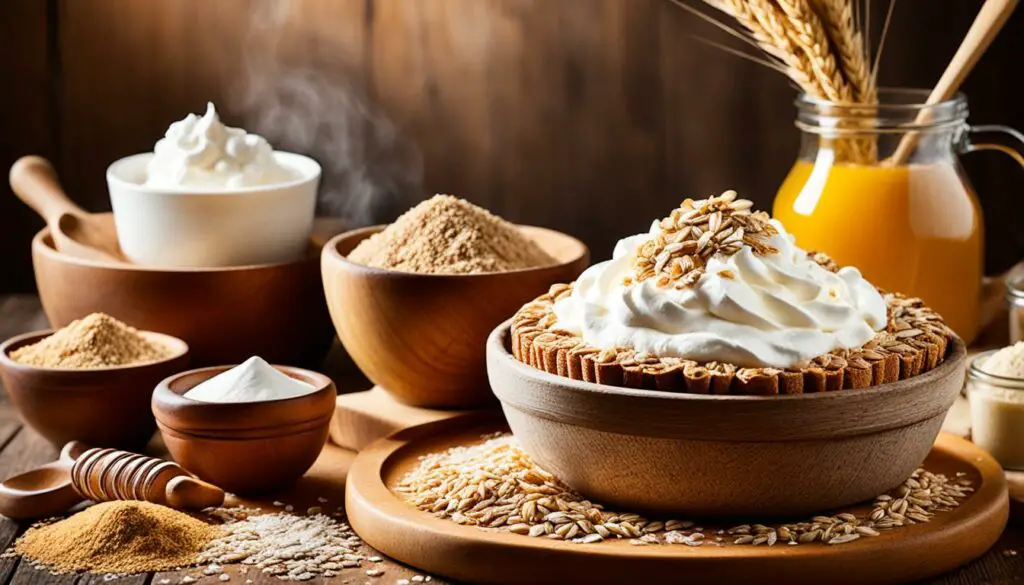
When it comes to yeast cake baking, choosing the right flour is crucial. While all-purpose wheat flour is commonly used, there is another type of flour that can take your yeast cake recipes to the next level. Meet the Polish “luksusowa” wheat flour type 550.
This flour is a game-changer for yeast cake enthusiasts. With its specific light wheat taste and slight buttery undertones, it adds a unique and rich flavor profile to your baked goods. The Polish 550 type flour elevates the taste of yeast pastries, giving them a deeper, more delicious flavor that will leave your taste buds dancing.
While US all-purpose flour can still produce great results, it is more forgiving in terms of sugar content. However, the taste may be slightly more bland compared to the yeast pastries baked with the Polish 550 type flour. So, if you’re seeking an authentic and flavor-packed yeast cake experience, experimenting with different flour types is highly recommended.
Benefits of Using Polish 550 Flour
“The Polish 550 flour adds a distinct taste and flavor to yeast-based pastries, making them more enjoyable and memorable. Its light wheat taste and buttery undertones create a unique and rich flavor profile that can’t be replicated with ordinary all-purpose flour. Elevate your yeast cake baking to a whole new level with this special flour.”
Best Yeast Cake Recipes Using Polish 550 Flour
- Cinnamon Rolls
- Nutella Babka
- Dinner Rolls
- Flatbread Dough
- Homemade Bread Bowls
These delectable recipes showcase the versatility and flavor potential of yeast cake baking with Polish 550 flour. Each recipe is an invitation to embrace the rich, buttery taste that this flour brings to your creations. Let your creativity run wild and explore the endless possibilities of yeast cake baking with the best recipes using Polish 550 flour.
Overcoming Intimidation and Mastering Yeast Cake Baking

Many people find yeast cake baking intimidating, but with practice and the right techniques, it can become a rewarding and enjoyable experience. Starting with simple recipes and following the five-step baking process can help build confidence.
- Start with simple recipes: Beginning with basic yeast cake recipes allows you to familiarize yourself with the process and build a solid foundation of baking skills. As you gain confidence, you can move on to more complex variations.
- Follow the five-step baking process: The five-step process of mixing, resting, shaping, resting again, and baking is essential for successful yeast cake baking. Each step contributes to the development of flavor, texture, and rise in the dough.
Experimenting with different variations of yeast cake recipes can add excitement and creativity to the baking process. Adding different flavors or fillings can enhance the taste and create unique combinations of ingredients. You can try incorporating ingredients like chocolate, fruits, nuts, or spices to add depth and complexity to your yeast cakes.
“Adding a hint of cinnamon to my yeast cake recipe created a warm and comforting flavor that my family loved. It’s a simple variation that adds a delightful twist to a classic recipe.”
Keeping in mind the tips for successful yeast cake baking is crucial for achieving optimal results. Here are some essential tips to consider:
- Maintain the right temperature: Yeast thrives in a warm environment, usually between 70 and 80 degrees Fahrenheit. Ensure that the dough is placed in a draft-free area with consistent warmth. Too much heat can kill the yeast, while cold temperatures can hinder the dough’s rise.
- Portion the grease: When greasing the baking pan or sheet, be sure to apply the right amount of butter or oil. Too little grease can cause sticking, while too much can make the dough heavy and greasy. Finding the balance is key to maintaining the freshness and texture of your yeast cake.
- Knead the dough well: Properly kneading the dough helps develop gluten and promote a light and airy texture. Aim for a smooth and elastic dough that springs back when lightly pressed. Kneading properly ensures that the yeast is evenly distributed throughout the dough, leading to a consistent rise.
By incorporating these tips and techniques into your yeast cake baking, you can overcome any initial intimidation and master the art of creating delicious and impressive yeast cakes.
Understanding the Different Forms of Yeast
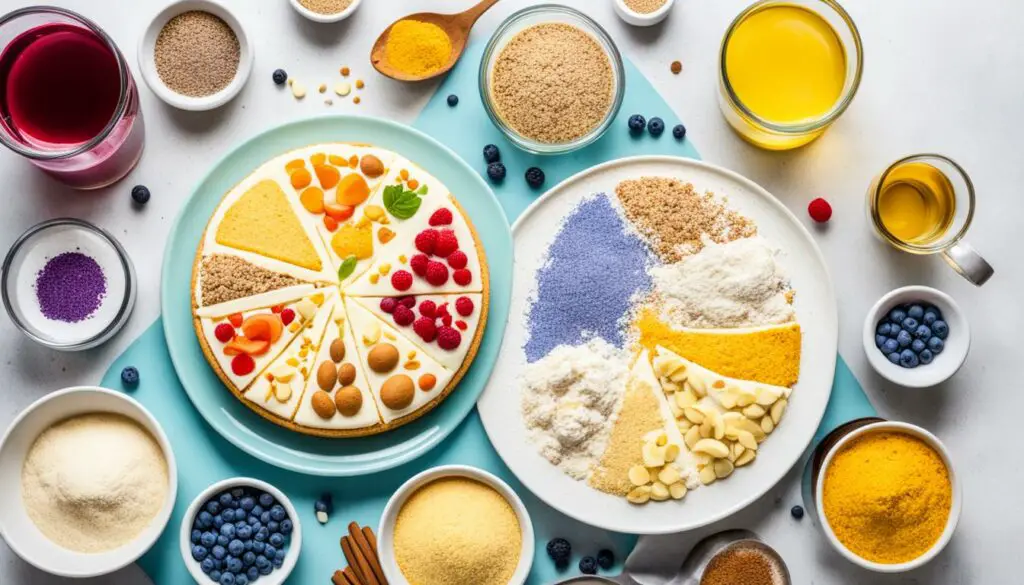
Yeast plays a vital role in baking, and it comes in different forms to suit various recipes and preferences. Understanding the different types of yeast can help you choose the right one for your baking needs.
Types of Yeast
There are three main forms of yeast commonly used in baking:
- Yeast Cake (Fresh Yeast or Compressed Yeast): Sold in the form of a block or cake, yeast cake is highly perishable but provides excellent leavening power. It requires proofing in warm water before use.
- Active Dry Yeast: This dry form of yeast is sold as small granules or pellets. It has a longer shelf life compared to yeast cake. Active dry yeast needs to be dissolved in warm water to activate before adding it to the dough.
- Instant Yeast (Quick-Rise Yeast or Bread Machine Yeast): Instant yeast is also a dry form of yeast, available as fine granules. It can be added directly to the dough without proofing in water, saving time in the baking process.
All three forms of yeast can be used interchangeably in recipes, with some adjustments in liquid amounts and rising times.
Choosing the Right Yeast
The choice of yeast depends on various factors, including personal preference, recipe requirements, and availability. Yeast cake is a preferred option for many professional bakers due to its superior leavening power and ability to produce light and airy pastries. However, it’s important to note that yeast cake is perishable and may not be readily available in all stores.
If you don’t have yeast cake on hand or struggle to find it, active dry yeast or instant yeast are excellent alternatives. Both types have a longer shelf life and can be stored for an extended period without losing their effectiveness.
Here is a side-by-side comparison of the different forms of yeast:
| Yeast Type | Perishability | Proofing Required | Usage |
|---|---|---|---|
| Yeast Cake (Fresh Yeast) | Highly perishable | Requires proofing in warm water | Ideal for pastries and yeast dough |
| Active Dry Yeast | Longer shelf life | Requires proofing in warm water | Versatile, suitable for most yeast recipes |
| Instant Yeast | Longer shelf life | No proofing required | Convenient for quick-rise recipes, bread machines, and pizza dough |
Each form of yeast has its own advantages, and the choice depends on your specific baking needs and preferences. Whether you opt for yeast cake, active dry yeast, or instant yeast, knowing how to use and store them correctly will help you achieve outstanding baking results.
Converting Dry Yeast to Yeast Cake
Dry yeast can be easily substituted for yeast cake in recipes. This allows for flexibility in using the available form of yeast without compromising the baking results. To convert dry yeast to yeast cake, follow these simple steps:
- Calculate the conversion: One 2-ounce yeast cake is equal to three packets (¼-ounce or 2 ¼ teaspoons each) of dry yeast.
- Prepare the dry yeast: Crumble the dry yeast over the dry ingredients or dissolve it in lukewarm liquid as per the recipe instructions.
- Adjust the liquid amounts: Since dry yeast requires different liquid amounts compared to yeast cake, it is important to adjust the liquid accordingly.
Converting dry yeast to yeast cake allows you to easily adapt your recipes and achieve the same great results. Whether you have yeast cake or dry yeast on hand, you can confidently bake delicious pastries and breads that will delight your taste buds.
Check out the table below for a quick overview of the conversion:
| Dry Yeast | Yeast Cake |
|---|---|
| 3 packets (¼-ounce or 2 ¼ teaspoons each) | One 2-ounce cake |
“Converting dry yeast to yeast cake allows you to easily adapt your recipes and achieve the same great results.”
Now you can confidently bake your favorite yeast cake recipes, whether you have yeast cake or dry yeast on hand. Experiment with different variations and enjoy the delectable treats you create.
The Importance of Resting and Kneading Dough
In the realm of yeast cake baking, two crucial steps contribute to the success of your baked goods: resting and kneading the dough. These steps play a key role in achieving that light and fluffy texture and beautifully risen bread that we all love.
When you allow the dough to rest, something magical happens. The gluten within the dough relaxes and settles, resulting in a more voluminous bread. Resting also makes the dough easier to shape, allowing you to create the perfect form for your yeast cake creations.
But what about kneading? Well, this step is where the artistry of yeast cake baking truly comes alive. Kneading the dough helps develop a delicate netting that traps air, assisting the dough in expanding and achieving its fluffy texture. To ensure a successful kneading process, your dough should be smooth, possess a light sheen, and exhibit elasticity.
Remember, when it comes to kneading, the amount of flour used is crucial. Use just enough flour to prevent sticking without making the dough too dry. Finding the right balance will ensure that your dough is in the perfect consistency for yeast cake perfection.
Properly resting and kneading the dough are essential for a successful yeast cake baking experience. These steps not only contribute to the texture and rise of your baked goods but also allow you to master the art of creating delectable pastries that will impress family and friends.
Common Challenges and Troubleshooting Tips
While yeast cake baking can be a delightful experience, it is not without its challenges. However, fear not! With a few troubleshooting tips, you can overcome these common baking hurdles. Let’s explore some of the most frequent issues and how to solve them.
1. Dough not rising properly:
If your dough fails to rise, there are several potential culprits. Cold temperatures, expired or dead yeast, excessive flour or sugar, and improper kneading can all hinder the rising process. To rectify this, ensure that your dough is in a warm environment, between 70 and 80 degrees Fahrenheit. Use fresh yeast within its expiration date for optimal results. Consider adjusting the amount of flour and sugar, and make sure to knead the dough sufficiently, just until it becomes smooth and elastic.
2. Sticky or difficult-to-shape dough:
A dough that becomes too sticky or challenging to shape can be frustrating. This issue often arises from using too little or too much flour during the kneading process. To remedy this, gradually add flour as needed while kneading until the dough reaches the desired consistency. Strike a balance between avoiding stickiness and ensuring the dough retains its moisture. Adjusting the flour amount during this stage can help you achieve the perfect texture for your yeast cake.
| Common Challenges | Troubleshooting Tips |
|---|---|
| Dough not rising properly | Ensure warm temperature, use fresh yeast, adjust flour and sugar quantities, knead adequately |
| Sticky or difficult-to-shape dough | Add flour gradually while kneading to achieve desired consistency |
Remember, troubleshooting is part of the baking journey. Embrace these challenges as learning opportunities and don’t be discouraged. With the right techniques and adjustments, you can conquer any yeast cake baking obstacle that comes your way!
Favorite Yeast Cake Recipes
Explore and try these delicious yeast cake recipes to satisfy your baking cravings. These recipes showcase the versatility and flavor of yeast cake in creating delectable pastries and baked goods. With a little practice and experimentation, you can even create your own variations of these recipes to suit your taste and preferences. Get ready to indulge in the world of yeast cake magic!
Cinnamon Rolls
You can never go wrong with homemade cinnamon rolls. The sweet and aromatic combination of cinnamon and sugar, wrapped in a soft and fluffy dough, makes them an irresistible treat for breakfast or dessert. Whether you drizzle them with cream cheese frosting or sprinkle them with powdered sugar, these cinnamon rolls will surely be a hit.
Nutella Babka
If you’re a fan of Nutella, then this Nutella babka recipe is a must-try. The rich and creamy chocolate-hazelnut spread swirled into a braided yeast dough creates a heavenly combination of flavors and textures. Serve it warm as a dessert or enjoy it with your morning coffee for a delightful start to the day.
Dinner Rolls
Soft and fluffy dinner rolls are the perfect accompaniment to any meal. Whether you’re hosting a holiday feast or simply want to elevate your weeknight dinner, these yeast cake-based dinner rolls will impress your guests. Slather them with butter or use them to make mini sandwiches – they’re sure to be a hit!
Flatbread Dough
Looking to create your own homemade flatbread? This yeast cake-based flatbread dough recipe will give you the perfect base for pizzas, wraps, or even as a side to your favorite curry. The dough’s soft and chewy texture, combined with the subtle flavor of yeast, will take your flatbread creations to the next level.
Homemade Bread Bowls
Why buy bread bowls when you can make them from scratch? These yeast cake-based homemade bread bowls are perfect for serving hearty soups, chowders, or even dips. The crusty exterior and soft interior make them the ultimate vessel for savoring your favorite comfort foods.
With these mouthwatering yeast cake recipes, your baking adventures are sure to be a success. Whether you’re a beginner or an experienced baker, these recipes offer a range of flavors and textures to satisfy every craving. So, grab your apron, preheat the oven, and let the magic of yeast cake take your baking to new heights!
Conclusion
In conclusion, yeast cake is a versatile and essential ingredient in baking, offering numerous benefits. It adds flavor and texture to a variety of pastries, transforming the dough into light and fluffy treats. Although yeast cake baking may initially seem daunting, with the right techniques and tips, it can be a delightful and rewarding experience.
Understanding the different forms of yeast, such as yeast cake, active dry yeast, and instant yeast, is crucial for successful baking. Being able to convert dry yeast to yeast cake allows for flexibility in recipe variations. Additionally, resting and kneading the dough properly ensures optimal rising and results in a delicious final product.
Furthermore, experimenting with different yeast cake recipes and variations adds creativity and excitement to the baking process. With practice, anyone can become skilled in yeast cake baking and create mouthwatering treats for themselves and their loved ones to enjoy. So don’t be afraid to dive into the world of yeast cake baking and let your culinary creativity soar!
FAQ
What is yeast cake in a recipe?
Yeast cake, also known as fresh yeast or compressed yeast, is a type of yeast that comes in the form of a cake or block. It is made up of living organisms that feed on sugar and convert it into alcohol and carbon dioxide through fermentation.
What are the uses of yeast cake?
Yeast cake is used as a key ingredient in a variety of recipes, including bread, rolls, pastries, and cakes. It adds flavor, texture, and helps the dough to rise.
How do you use yeast cake in baking?
Baking with yeast cake typically involves a five-step process: mixing and kneading the dough, allowing it to rest and rise, shaping the pastry, and baking it at the appropriate temperature.
What are some tips for successful yeast cake baking?
To ensure successful yeast cake baking, it is important to provide the dough with a warm place to rest, adjust the baking temperature based on the recipe’s sweetness, use more egg yolks for airier cakes, grease the pastry adequately, and add salt to enhance flavor.
What is the best flour for yeast cake baking?
While all-purpose wheat flour is commonly used, using Polish “luksusowa” wheat flour type 550 can provide a more authentic taste and flavor. Experimenting with different flour types is recommended to find the perfect balance of taste and texture.
How can I overcome the intimidation of yeast cake baking?
Starting with simple recipes, following the five-step baking process, and experimenting with different variations can help build confidence and make yeast cake baking a rewarding experience.
What are the different forms of yeast?
Yeast comes in different forms, including yeast cake, active dry yeast, and instant yeast. Each form has its own characteristics and can be used interchangeably with the appropriate adjustments.
How do you convert dry yeast to yeast cake?
To convert dry yeast to yeast cake, use the following conversion: one 2-ounce yeast cake is equal to three packets (¼-ounce or 2 ¼ teaspoons each) of dry yeast. Adjust the liquid amounts accordingly.
Why is resting and kneading the dough important in yeast cake baking?
Resting the dough allows the gluten to relax and settle, resulting in a more voluminous bread. Kneading the dough helps develop a netting that traps air and helps the dough expand.
What are some common challenges in yeast cake baking and how can they be overcome?
Common challenges in yeast cake baking include dough not rising properly and sticky or difficult-to-shape dough. Adjusting factors such as temperature, yeast freshness, flour and sugar amounts, and kneading technique can help overcome these challenges.
What are some favorite yeast cake recipes?
Some popular yeast cake recipes include cinnamon rolls, Nutella babka, dinner rolls, flatbread dough, and homemade bread bowls. Experimenting with different flavors and fillings can add excitement and creativity to the baking process.
What are the benefits of yeast cake and some tips for baking it?
Yeast cake adds flavor and texture to baked goods and helps the dough to rise. Tips for successful yeast cake baking include maintaining the proper temperature, using the right amount of grease, and kneading the dough well.

